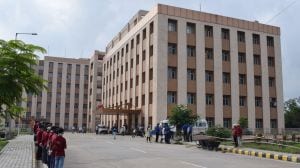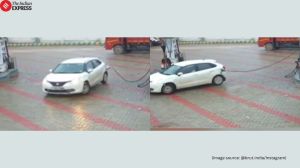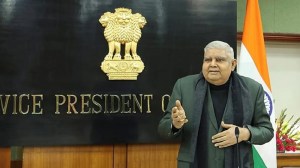Seven major fires in a fortnight: What’s fuelling Mumbai’s sudden spate of blazes?
Amid the surge in fire incidents across the city, senior officials of the Mumbai Fire Brigade pointed to the rise in temperatures, corresponding with the increased usage of air conditioners as one of the primary causes--besides other factors--for the sudden spike.
 Mumbai has witnessed an unusual surge in fire outbreaks, with at least seven major blazes reported across residential, commercial and government properties (File Photo/Representative)
Mumbai has witnessed an unusual surge in fire outbreaks, with at least seven major blazes reported across residential, commercial and government properties (File Photo/Representative)Over the past two weeks, Mumbai has witnessed an unusual surge in fire outbreaks, with at least seven major blazes reported across residential, commercial and government properties. From malls to high-rise buildings, these fires have claimed three lives and left behind charred structures leaving individuals financially devastated. As temperatures soar and old electrical systems crack under pressure, experts and fire officials warn that a deadly mix of summer heat, poor maintenance and lax fire audits may be fuelling the city’s sudden spate of fires.
Sudden fire outbreaks
Amid the surge in fire incidents across the city, senior officials of the Mumbai Fire Brigade pointed to the rise in temperatures, corresponding with the increased usage of air conditioners as one of the primary causes–besides other factors–for the sudden spike.
Speaking to The Indian Express, a senior MFB official said, “While there are multiple reasons for different cases, rise in temperatures is a key reason for fires during summer as there is a sudden increase in the usage of air conditioners. Furthermore, most old buildings have old wiring, which has to face the brunt of the continuous usage of AC.”
“If these ACs work non-stop, without maintenance, the dust particles get jammed within and cause friction. At the same time, external heating during summer further triggers the internally heated air condition units, triggering short-circuits,” added the official.
Another senior official from the MFB headquarters also echoed that fire outbreaks tend to see an increase during summer, when heatwaves are more prevalent.
In a statement issued Monday, the MFB said that heatwaves increase the risk of fire due to increased temperature, heating of electrical wiring, air conditioning systems, fridges and other appliances and the consequent stress on electricity consumption.
Data from the MFB shows a 5% rise in fire incidents in 2024, with 5,301 cases reported compared to 5,074 in 2023. The summer months saw the highest numbers: 484 fires in April, 473 in March, and 468 in May.
However, some experts echoed that fire cannot be solely attributed to seasonal factors. “According to statistics, nearly 70 percent of fires have electrical origins but they are distributed across the year. While it is true that the city sees peak load during summers especially in a coastal city like Mumbai where AC is used nearly 24X7 in hospitals, hotels and some houses as well, if an establishment is able to fix the defective electric systems, then the root cause of big fires will be controlled by nearly 70 percent,” said a veteran firefighter with the MFB, requesting anonymity.
Concern over inadequate fire audits
According to Vivek Pai, urban planner, the recent spate of fires in Mumbai display alarming commonalities. “In the recent cases, a majority of the fires were electrical in nature and they all took place during the nighttime. In most of the incidents, there were obstructions seen along the fire pathway, and it was also found that there was a lack of proper audit,” said Pai.
The current trend as well as the rise in numbers have raised concerns over the inadequate fire audits across the city’s high-rises as well as commercial and small-scale establishments.
“Whenever there is a heatwave, the government issues an advisory to conduct fire audits. However, most establishments often fail to conduct them timely,” said an MFB official.
As per the Maharashtra Fire Prevention and Life Safety Measures Act of 2006, the responsibility of fire audits lies with the owner or the occupant of the building, who are mandated to carry out half-yearly audits through approved license agencies. These audits are conducted to inspect the operations of active and passive fire-fighting systems within a building.
These approvals follow a primary approval which is issued by the MFB, during the course of a structure’s construction. In Mumbai, each building — depending on its size, structure, function — is mandated as per the BMC’s Development Control & Promotion Regulation 2034 (DCPR 2034) to comprise an array of active fighting systems such as alarm system, sprinkler system, fire hydrants among others besides passive measures ranging from the number of staircases required, horizontal or vertical exits etc. Following inspection of these measures, the MFB grants a provisional fire safety approval during construction, followed by the final fire safety approvals for part occupation.
An official said: “After we issue the final fire safety approvals, the establishments and societies are mandated to conduct fire audits regularly, on the basis of which we issue Form B. This is to ensure that the active and passive systems are in good shape and functional. But several buildings, societies and other structures, fail to keep up with the timely inspections.”
What can citizens do?
While at a large scale, establishments like schools, housing societies, malls, hospitals among others are mandated to carry out safety audits to ensure that all fire-fighting systems are in place, officials said that citizens can safeguard their homes through regular maintenance and inspections, at an individual level.
“Since overloading of ACs can be a common cause for fires, people should ensure that these air conditioning units are used with breaks at intervals. This can prevent overheating and burden,” said a senior MFB official, adding that people must carry out quarterly maintenance of the machines to ensure smooth functioning.
“Not only that but also buildings with wirings that are 25 to 30-year-old, are also prone to experience more instances of short-circuit. Since the old wirings have low load bearing capacity, these wirings should be replaced to prevent untoward overburdening.”
Experts like Vivek Pai, meanwhile, also called for the need for regular fire drills in a bid to acquaint residents and workers of a building with the firefighting system.
“Whenever a fire breaks out, often people are not aware of the Assembly points and how to escape. Such fire drills, therefore, must be made mandatory. Every establishment should do an awareness drive, at least once a year, to be prepared in case of fire. They should be able to use a fire extinguisher, know how to escape to safety etc,” added Pai.
Besides this, Rajnish Kumar–a fire safety expert–added that the area around AC exhausts in windows and balconies should not be blocked with items, to enable the winds to flow freely and prevent overheating. “On an individual level, one can also make sure that they keep their stairways clear to reduce risks during fire cases,” added Kumar.
Going forward
In the wake of fire incidents in the city recording an uptick, the Mumbai Fire Brigade on Monday issue fresh advisories and precautions to prevent fires during heatwaves across the city’s high rises, and other establishments. The guidelines have come along the heels of the union ministry circulating a list of directives and precautions for the same.
Meanwhile, the MFB–in the ongoing fiscal year–is also eyeing to establish nearly seven new fire stations across Mumbai of which at least two new stations are proposed along the Mumbai coastal road project. Having earmarked a budget of nearly Rs 261.72 crore in FY 2025–2026, the MFB has also chalked plans to procure new additional vehicles ranging from two advanced fire-fighting robots, mini water tenders, hydraulic platforms, drones etc.












